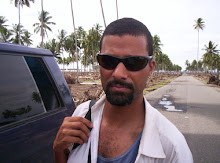
When a tsunami comes on land, it usually brings a lot of sand with it, depositing it on land as the wave slows, then retreats back to the ocean. These 'tsunami deposits' are a powerful tool for determining the recurrence interval of tsunamis on a given coastline. Now, researchers are working on determining the size of the tsunami that left the deposit based on the distribution of sand grains of different sizes.
In the 1980s, researchers in the Pacific Northwest lead by Brian Atwater of the US Geological Survey, discovered sand layers buried in marshes up and down North America's west coast- from northern California to Vancouver Island. These deposits were lain by a massive tsunami that hit around 1700 AD according to carbon-14 dating, confirmed by a tsunami that hit Japan that year. This groundbreaking work brought to light a hazard that was previously unrecognized in this region.
Recent discoveries in Thailand (pictured above) and Aceh Province show that large tsunamis occur in this region every 300-600 years. There was one event that hit Aceh in 1907 that was not recorded in Thailand, but we do not know how large that event was. Our team is planning to go back to Aceh to collect more detailed sediment samples with the aim of calculating the magnitude of past tsunamis.
These data will be critical to those planning for future events. Right now, many planners and NGOs are planning for a 2004-scale event every 45 years. A magnitude 9.2 earthquake generating a basin-wide tsunami that kills 250,000 people every 45 years! Perhaps we should air on the side of caution here, but resources could and should be directed toward more critical needs that might be overlooked in the face of such a potential disaster in the relatively near future.




